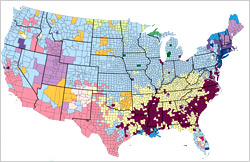
Last year, when the debt ceiling crisis put the U.S. government on the brink of default on trillions of public borrowings, Republicans and
Democrats came to a last-minute agreement to cut $2.4 trillion in spending over the next decade beginning in January 2013.
Much of the detail of those spending reductions has been left to a
special Congressional committee, but as currently proposed, they would end the Bush-era tax cuts and mandatory federal spending cuts imposed by compromise legislation last year.
But
according to Credit Suisse economist Dr. Neal Soss, the compromise plan would have the effect of chopping nearly 4 percentage points off the gross domestic product and tossing the country back into
another recession. That’s why Soss and others believe the government will come up with another plan.
“Most of the forecasting community has said ‘no we won’t do
it’,” Soss told attendees at the TVB Forward Conference in New York on Wednesday.
Other groups such as the International Monetary Fund have urged the U.S. to address the
so-called “fiscal cliff” that awaits the American economy when the current plan is set to kick in at the beginning of next year.
Still, Soss claims that whatever plan is
embraced will have a negative impact on GDP. He believes that a revised plan would have a “less than recessionary” effect of around 1.5%.
The IMF and other groups have recently
downgraded their estimates for GDP growth for the U.S. this year and next. The IMF now says U.S. GDP will grow 2% this year and 2.25% in 2013.
Those estimates parallel recent downgrades of
ad spending growth and a prediction earlier this week by Pivotal Research senior analyst Brian Wieser that the advertising environment will remain tough until the latter part of 2013.
advertisement
advertisement